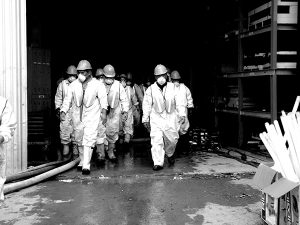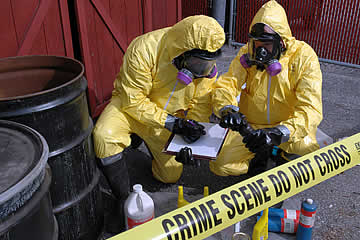Sewage Cleanup Providers: Fast and Safe Remediation of Contaminated Locations
Sewage Cleanup Providers: Fast and Safe Remediation of Contaminated Locations
Blog Article
Specialist Biohazard Cleaning and Decontamination for Blood, Bodily Fluids, and Hazardous Materials
The possible wellness dangers connected with direct exposure to biohazards emphasize the important requirement for thorough handling and detailed clean-up. As we browse the elaborate landscape of biohazard clean-up, understanding the nuances of regulations, conformity, and the specialized equipment at play comes to be critical in ensuring a complete and risk-free purification procedure.
Wellness Risks of Biohazard Exposure
Direct exposure to biohazards presents substantial wellness dangers that can cause extreme consequences for neighborhoods and people alike. Biohazards include a wide variety of organic substances, consisting of blood, bodily fluids, mold and mildew, germs, infections, and other potentially contagious materials. When individuals enter call with these biohazards, whether through crashes, improper handling, or environmental exposure, they deal with the danger of having major illnesses or conditions.
Among the main health risks connected with biohazard exposure is the transmission of transmittable conditions. Bloodborne pathogens such as HIV, liver disease B and C, and various bacteria can be present in biohazardous products, positioning a straight risk to human wellness. Inhaling airborne biohazards like mold spores or entering call with polluted surfaces can likewise bring about breathing concerns, allergies, and other adverse wellness results.
Additionally, biohazard exposure can have lasting wellness ramifications, with some conditions materializing years after the preliminary call (Blood Cleanup). As a result, it is important to focus on appropriate biohazard cleaning and purification to alleviate these health dangers and guarantee the security of communities and individuals

Specialized Training for Biohazard Clean-up
When it pertains to taking care of biohazard cleanup successfully and safely, specialized training plays an essential duty in making certain proper decontamination treatments are followed. Biohazard clean-up requires certain knowledge and skills to effectively reduce threats related to bloodborne microorganisms, physical liquids, and hazardous products. Professionals educated in biohazard clean-up undertake strenuous guideline on exactly how to safely manage, eliminate, and get rid of biohazardous materials to avoid contamination and direct exposure.
Specialized training for biohazard clean-up covers an array of essential topics, consisting of proper personal safety tools (PPE) use, bloodborne microorganism understanding, decontamination strategies, and unsafe waste disposal procedures. People trained in biohazard clean-up are furnished with the essential experience to evaluate contamination degrees, determine possible threats, and apply appropriate cleanup procedures in compliance with governing requirements.
Continual training and education and learning are vital in the area of biohazard cleaning to stay upgraded on the most up to date decontamination technologies, safety protocols, and laws. By purchasing specialized training, biohazard cleaning experts can efficiently reply to emergency cleanup situations and secure both public health and wellness and the environment.
Importance of Appropriate Purification Techniques
Using appropriate decontamination techniques is crucial in biohazard cleanup to properly decrease and remove hazardous products wellness risks. Reliable decontamination not only guarantees the removal of visible traces of blood, physical liquids, and other biohazards yet also targets unnoticeable microorganisms that might present significant wellness risks if not effectively the original source eliminated. By adhering to rigorous decontamination methods, educated professionals can substantially reduce the threat of exposure to dangerous microbes, viruses, and germs that could lead to conditions or infections.
Correct decontamination strategies entail making use of customized tools and disinfectants that are particularly made to counteract biohazards efficiently. Extensive cleansing and sanitation of contaminated locations are crucial to prevent the spread of microorganisms and guarantee a secure setting for residents. Additionally, the appropriate disposal of biohazardous waste adhering to purification treatments is crucial in protecting against contamination of various other surfaces or people.

Devices and Tools for Safe Clean-up
When dealing with blood, bodily fluids, or dangerous materials, biohazard cleansing specialists count on specialized gear to decrease direct exposure risks and completely decontaminate the afflicted area. Furthermore, biohazard cleansing kits consisting of disinfectants, absorbing materials, and biohazard bags are made use of to securely have and get rid of of infected products.
Advanced cleaning tools like hospital-grade disinfectants, HEPA-filtered vacuums, and fogging machines are utilized to disinfect surfaces and eliminate biohazards successfully. Specialized tools such as sharps containers and biohazard garbage disposal containers are made use of to safely take care of sharp objects and biohazardous waste materials. By using the appropriate tools and devices, biohazard cleaning professionals can make certain a comprehensive cleanup process that prioritizes safety and security and decreases health and wellness content threats for both employees and occupants of the damaged area.
Laws and Conformity in Biohazard Cleaning
Appropriate adherence to laws and conformity criteria is extremely important in biohazard cleansing to make sure the safety of both employees and the setting. Federal government agencies such as OSHA (Occupational Safety and Health Administration) and the EPA (Environmental Security Firm) have actually established specific standards for biohazard clean-up treatments to reduce health threats and environmental contamination. These guidelines cover a variety of facets including the handling, transport, and disposal of biohazardous products, in addition to the needed training and safety devices required for Click This Link employees involved in the clean-up process.
Biohazard cleaning firms should remain updated with these laws to ensure that their operations fulfill the needed safety requirements. Failing to follow these guidelines can lead to serious effects, including penalties, legal activity, and endangering the health and wellness of people and the environment. By adhering to rigorous guidelines and compliance actions, biohazard cleaning companies can efficiently alleviate risks and ensure a detailed and secure cleanup procedure for all parties entailed.
Final Thought
To conclude, biohazard cleaning and purification require customized training, appropriate techniques, and adherence to policies. Exposure to blood, bodily liquids, and dangerous materials presents significant wellness dangers, making it essential to utilize the appropriate equipment and tools for secure clean-up. By adhering to stringent procedures and standards, specialists can efficiently minimize the threats related to biohazard direct exposure and ensure the safety and security of both themselves and others.
As we browse the detailed landscape of biohazard cleaning, understanding the nuances of guidelines, conformity, and the specialized tools at play comes to be critical in ensuring a risk-free and detailed decontamination procedure. (Blood Cleanup)
When it comes to handling biohazard cleaning successfully and safely, specialized training plays an essential role in guaranteeing proper purification treatments are complied with.Utilizing proper decontamination strategies is vital in biohazard clean-up to efficiently minimize and get rid of dangerous products wellness threats. In addition, biohazard cleansing sets containing anti-bacterials, absorptive products, and biohazard bags are utilized to securely dispose and have of infected products.
Government agencies such as OSHA (Occupational Safety And Security and Health And Wellness Management) and the EPA (Environmental Defense Agency) have developed specific guidelines for biohazard cleaning treatments to reduce health and wellness risks and ecological contamination.
Report this page